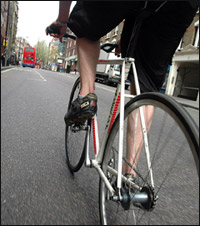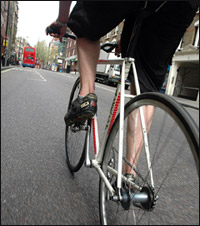In the rich mosaic of North American society, I stand rather forlornly on my own as a member of an oft-forgotten minority group: I am an adult male who can’t drive.

I have a wheelie bad feeling about this.
Photo: Andrew White.
Catapulted into the overcrowded car culture of Vancouver, British Columbia, from the U.K. last January, I quickly found myself labeled as a maverick and an outcast. People looked at me as if I were mad, misinformed, incapable, or just plain wacky. They told me that the honeymoon couldn’t last — that I wouldn’t survive, that the long walks to the supermarket would drive me crazy, the bus timetables would break my resolve, the isolation would eat away at me bit by bit. That one day I would reach rather haplessly for the phone book with the loaded intention of making that once-in-a-lifetime, all-important call: the driver’s education program.
In the grand old tradition of blundering British eccentricity, I scoffed, determined to prove them wrong. I decided to carve out my newfound Canadian identity rather defiantly on my own — with a bicycle. I bought a cheap mountain bike from a shop in Vancouver and set about dodging the local traffic with a tenacity matched only by my desire to dodge driving lessons.
North America with no driver’s license — was it possible?
Possible, yes. But I have to confess, even after a decade’s worth of world travel and a level of blinkered obstinacy that would make a mule seem positively docile, the challenge wasn’t easy.
As a former resident of England — a country that crams 25 million cars into a land mass about a quarter the size of California — I was somewhat shocked by the sleek and sexy image still enjoyed by automobiles in North America. Back in my home country, a radically different story was unfolding; the gridlocked nation’s patience had just about reached a breaking point.
One of the chief proponents of change was Ken Livingstone, London’s mayor and the inspiration behind the city’s notorious “congestion charge.” In 2003, the capital began collecting £5 from every driver entering its central zone during peak hours, a move that cut traffic by nearly 20 percent. Never one to mince words in public, Livingstone continued his attack last year, branding parents who drove their children to school in SUVs as “idiots” on live television.
Well, that’s one approach. I’d seen others during a string of global work sabbaticals — experiences that took me to approximately 65 countries where I managed to get by without a license. Spending 18 months in the sultry heat of the Caribbean, I had suffered the ignominy of a car-free existence in its most radical incarnation — embargo-strapped Cuba. In 1991, following the collapse of the Soviet Union, the Cuban transportation system fell into ruins, robbed of its subsidized oil supply. Castro’s answer: the purchase of 1.2 million single-gear Chinese bicycles.
Cubans have always prided themselves on their mechanical ingenuity, and after decades of stuffing Lada engines under the hoods of vintage Chevrolets, it’s easy to see why. In the true spirit of the “waste not, want not” rationing economy, the new bicycles were quickly tuned up and made roadworthy, and an ecologically reborn Castro demonstrated to the world that bikes could be the new SUVs.
I also had the good fortune to live in Copenhagen, Denmark. Copenhagen’s prosperous metro area is home to just over 1 million people, with a climate not dissimilar to New York or Toronto. But that’s pretty much where the likeness ends. Throw a stone into a busy Copenhagen street on any chosen morning in spring and, more likely than not, you’ll hit one car — and about 10 bicycles. The Danes — who, in contrast to the Cubans, are neither communists nor particularly good dancers — have been educating themselves to be less dependent on cars for more than 30 years, and have developed a highly efficient transportation system as a result.
So it can be done. But to lifelong car dodgers, North America is a different proposition — bigger, brasher, and infinitely less forgiving. And it almost got the best of me.
One day, cycling legs temporarily depleted and confidence mildly dented after an unsuccessful attempt to hitch into Vancouver on Highway 99, I decided to look for a bus stop or a tube station. It was like looking for a needle in a haystack. Contrary to urban myth, tubes don’t actually exist in Canada (they call them SkyTrains), and hanging around at bus stops is largely fruitless, unless you come equipped with an overnight bag and the patience of a saint.
Fed up with waiting, I got rather foolishly back on my bike and headed city-central way, a fragile, bloody-minded Englishman lost in the ugly sprawl of car-cloned North America. And for one nasty moment — despite having survived communist Cuba and the sturdy fortitude of the stiff-upper-lip Danes — I thought of making that apocalyptic call. I would dial up the dreaded driving school for a spontaneous audition.
But then, through a fog of exhaust fumes and hunger pangs, I saw it: the little green sign with the oil-splattered white bike painted on it. The last unblemished piece of cycle lane west of Bermuda.
It was like an epiphany, a mirage, a prophetic reminder that all was not lost — that I could get through this if I kept on trying; that I could beat these environmental fact-dodgers as long as I kept my eyes on the tarmac, avoided numerous shards of smashed wing mirror, and ignored the omnipresent threat of Jeep drivers jockeying rudely for position in my wake.
I rode toward the glittering skyline of downtown Vancouver, and soon the lush green expanse of Stanley Park materialized out of the urban sprawl. I had made it. I began to feel a little clearer about my destiny, a shade less daunted by my battle. I found myself hoping others, too, would park and ride.
A more determined cyclist than me, alluding to his feisty battle against testicular cancer, once uttered a memorable phrase: “It’s not about the bike.” To which I might add: no, and it’s not about Ken Livingstone, Danes in bicycle lanes, or the capricious whims of Fidel Castro either. Rather it’s about me and you, us and them, him and her. It’s about adaptation. It’s about … the future.


